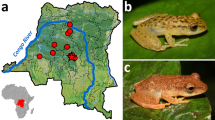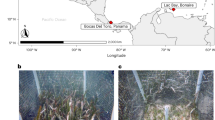Summary
Populations of Cepaea nemoralis and C. hortensis have been sampled in a small area in north-west Worcestershire. No clear ecological separation between the two species is apparent.
Morphs of C. nemoralis that one would expect to vary in frequency between woods and open habitats on the basis of visual selection do so in the manner expected.
The variation shown by C. hortensis in the region is quite different and much reduced, compared with that of C. nemoralis. The expected differences between woods and open habitats still occur, however. Tests for any relations between morph-frequency and two other environmental variables (altitude and proximity to water) have been made. Only altitude shows such relations: unbanded in C. hortensis tends to rise in frequency with altitude and listeria in C. nemoralis may do so.
The Index of Polymorphism of C. nemoralis is always high if C. hortensis is present, but may be low if the latter is absent. Several mechanisms which could explain this are suggested. Linkage disequilibria are apparent in C. nemoralis. Banding is deficient in browns and at an excess in yellows, compared with pinks, in all habitats. It is concluded that the diversity of selective forces acting affectively on Cepaea populations, not random events, is responsible for the wide variation between them in morph-frequencies.
Similar content being viewed by others
Article PDF
References
Bantock, C R, and Noble, K. 1973. Variation with altitude and habitat in Cepaea hortensis (Müll.). Zool J Linn Soc, 53, 237–252.
Cain, A J, Cameron, R A D, and Parkin, D T. 1969. Ecology and variation of some helicid snails in Northern Scotland. Proc malac Soc Lond, 38, 269–299.
Cain, A J, and Currey, J D. 1963a. Area effects in Cepaea. Phil Trans Roy Soc Lond, B, 246, 1–81.
Cain, A J, and Currey, J D. 1963b. Area effects in Cepeae on the Larkhill Artillery Ranges, Salisbury Plain. J Linn Soc Lond (Zool), 45, 1–15.
Cain, A J, and Sheppard, P M. 1950. Selection in the polymorphic land snail Cepaea nemoralis. Heredity, 4, 275–294.
Cain, A J, and Sheppard, P M. 1954. Natural selection in Cepaea. Genetics, 39, 89–116.
Cameron, R A D. 1969. The distribution and variation of three species of land snail near Rickmansworth, Hertfordshire. J Linn Soc (Zool), 48, 83–111.
Cameron, R A D. 1970a. The survival weight-loss and behaviour of three species of land snail in conditions of low humidity. J Zool Lond, 160, 143–157.
Cameron, R A D. 1970b. The effect of temperature on the activity of three species of Helicid snail (Mollusca: Gastropoda). J Zool Lond, 162, 303–315.
Cameron, R A D. 1970c. Differences in distribution of three species of helicid snail in the limestone district of Derbyshire. Proc Roy Soc. B, 176, 131–159.
Carson, H L. 1955. The genetics of marginal populations of Drosophila. Cold Spring Harbor Symp Quant Biol, 20, 276–287.
Carson, H L. 1958. The population genetics of Drosophila robusta. Adv Genetics, 9, 1–40.
Clarke, B C. 1960. Divergent effects of natural selection on two closely-related polymorphic snails. Heredity, 14, 423–433.
Clarke, B C. 1962a. Natural selection in mixed populations of the polymorphic snails. Heredity, 17, 319–345.
Clarke, B C. 1962b. Balanced polymorphism and the diversity of sympatric species. In Taxonomy and Geography, ed. D. Nichols, Syst. Ass. Pub. No. 4.
Clarke, B C, and Murray, J J. 1962. Changes of gene frequency in Cepaea nemoralis (L.). Heredity, 17, 445–465.
Cooper, D W. 1969. The significance level in multiple tests made simultaneously. Heredity, 23, 614–617.
Currey, J D, Arnold, R W, and Carter, M A. 1964. Further examples of variation of populations of Cepaea nemoralis with habitat. Evolution, 18, 111–117.
Elton, R A, and Greenwood, J J D. 1970. Exploring apostatic selection. Heredity, 25, 629–633.
Goodhart, C B. 1956. Genetic stability in populations of the polymorphic snail, Cepaea nemoralis. Proc Linn Soc Land, 167, 50–67.
Goodhart, C B. 1958. Genetic stability in the snail Cepaea nemoralis (L.): a further example. Proc Linn Soc Lond, 169, 163–167.
Greenwood, J J D. 1969. Apostatic selection and population density. Heredity, 24, 157–161.
Guerrucci-Henrion, M A. 1966. Recherches sur les populations naturelles de Cepaea nemoralis en Bretagne. Arch Zool Exp Gen, 107, 369–417.
Lamotte, M. 1954. Sur le determinisme génétique du polymorphisms, chez Cepaea nemoralis L. CR Acad Sci, 239, 365–367.
Lamotte, M. 1959. Polymorphism of natural populations of Cepaea nemoralis. Cold Spring Harbor Symp Quant Biol, 24, 65–86.
Parsons, P A. 1966. The genotypic control of longevity in Drosophila melanogaster under two environmental regions. Aust J Biol Sci, 19, 587–591.
Sheppard, P M. 1951. Fluctuations in the selective value of certain phenotypes in the polymorphic land snail Cepaea nemoralis (L.). Heredity, 5, 125–134.
Sheppard, P M. 1952. Natural selection in two colonies of the polymorphic land snail Cepaea nemoralis. Heredity, 6, 233–238.
Simpson, E H. 1949. Measurement of diversity. Nature, 163, 688.
Whitney, D R, and Mann, H B. 1947. On a test of whether one or two random variables is stochastically larger than the other. Ann Math Statist, 18, 50–60.
Author information
Authors and Affiliations
Rights and permissions
About this article
Cite this article
Greenwood, J. Visual and other selection in Cepaea: A further example. Heredity 33, 17–31 (1974). https://doi.org/10.1038/hdy.1974.61
Received:
Issue date:
DOI: https://doi.org/10.1038/hdy.1974.61
This article is cited by
-
Genetic variability and environmental variability in the estuarine isopod Sphaeroma rugicauda
Heredity (1985)
-
Further associations between morph-frequency and coexistence in Cepaea
Heredity (1980)
-
Morph-frequency and co-existence in Cepaea
Heredity (1978)
-
Geographical variation in populations of the polymorphic isopod, Sphaeroma rugicauda
Heredity (1975)



